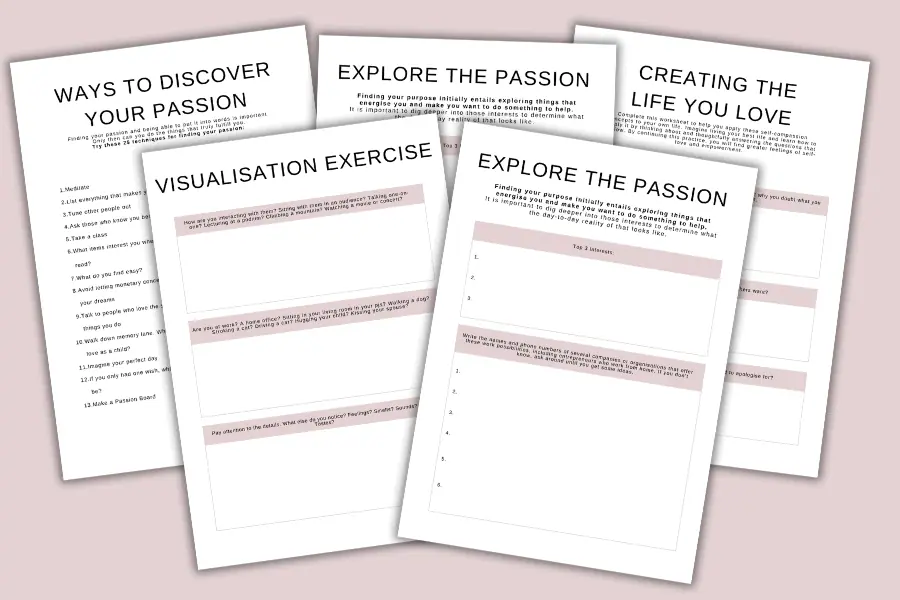8 Essential Steps On How To Write A Gratitude Journal

Sometimes it’s easy to overlook the positive aspects that surround us. This is where the beauty of a gratitude journal comes in. So, what exactly is a gratitude journal? It’s a personal space where you jot down the things you’re thankful for—a daily ritual that helps you cultivate a mindset of appreciation.
But, you might wonder, what makes it different from a regular journal? Well, a gratitude journal focuses specifically on the positive moments and aspects of your life. It’s a bit like capturing sunshine in a bottle; you take a moment each day to collect the rays that brighten your world.
As we delve into the details of how to write a gratitude journal, keep in mind that this isn’t just a feel-good exercise. It’s a scientifically-backed tool for boosting your mood and building resilience in the face of life’s challenges. So, let’s embark on this journey together and explore the art of gratitude journaling—it might just be the positive change you’ve been looking for.
This blog post is about how to write a gratitude journal

How to Get Started With a Gratitude Journal
Selecting a journal
Embarking on your gratitude journaling adventure begins with a simple yet meaningful decision—choosing the right journal. Your journal is like a trusted companion, a keeper of your reflections, so it’s essential to pick one that resonates with you. Whether it’s a sleek notebook or a vibrant journal, find something that sparks joy and encourages you to return to its pages.
Consider the size and feel of the journal. Do you prefer a pocket-sized companion or a more spacious canvas? The tactile experience matters; the act of writing should feel comfortable and inviting. Your journal is a reflection of your gratitude journey, so let it be a canvas that inspires you to express thanks.
Choosing a regular time to write
Consistency is the key to making gratitude journaling a habit. To make it seamlessly fit into your routine, designate a specific time each day to write in your journal. It could be the quiet moments before bedtime, a tranquil morning ritual, or even a brief pause during lunch.
The goal is to make this a stress-free and enjoyable experience. So, ask yourself: when do you feel most at ease? Finding the right time ensures that gratitude journaling becomes a natural part of your day, like sipping your favourite tea or taking a refreshing walk.
Remember, there’s no one-size-fits-all approach. Experiment with different times until you discover what works best for you. This personalised touch is what transforms your gratitude journal from a task into a cherished habit, making the practice more sustainable and rewarding. Now, armed with your chosen journal and a dedicated time slot, you’re ready to dive into the world of gratitude journaling.
Setting the Mood
Creating a calm environment
Now that you’ve got your journal in hand, it’s time to set the stage for your gratitude journaling ritual. Creating a calm environment is like dimming the lights for a cosy dinner—it enhances the experience. Find a quiet spot where you can unwind, free from the hustle and bustle of daily life.
Consider adding a touch of serenity to your space. Maybe it’s a soft blanket, a flickering candle, or the gentle hum of instrumental music. The idea is to make your gratitude journaling a moment of tranquillity amidst the noise of the world. This environment invites you to pause, reflect, and express gratitude.
Eliminating distractions
In the digital age, distractions lurk around every corner, ready to snatch our attention. To truly connect with your gratitude journal, it’s essential to create a distraction-free zone. Power down electronic devices, silence notifications, and let your mind breathe without constant interruptions.
Think of it as a mini digital detox—a time to unplug and reconnect with the simplicity of pen and paper. This deliberate act of eliminating distractions allows you to focus entirely on the positive moments you want to capture in your gratitude journal. It’s a gift to yourself, a moment of undivided attention to the things that bring joy and gratitude to your life.
As you embark on this journey of setting the mood for your gratitude journaling practice, remember: that a calm environment and freedom from distractions lay the foundation for a more mindful and fulfilling experience. Now, with your serene space established, let’s explore the techniques of how to write a gratitude journal with clarity and purpose.
Writing Techniques
Specificity in gratitude entries
Now that you’re seated in your calm corner with your chosen journal, let’s dive into the art of crafting gratitude entries. The magic lies in being specific. Instead of a generic “I’m thankful for my family,” delve deeper. Consider the unique moments, gestures, or qualities that make your family special.
For instance, “I appreciate the laughter shared during Sunday brunch with my family, creating a warm and vibrant atmosphere.” Specificity adds colour to your entries, making them more vivid and memorable. It’s like capturing a snapshot of gratitude, freezing a moment in time that you can revisit and savour.
Describing emotions associated with gratitude
Writing about what you’re thankful for is one aspect, but don’t forget to explore how it makes you feel. Describe the emotions associated with each gratitude entry. Is it joy, warmth, or a sense of peace? Connecting your feelings to your expressions deepens the impact of your gratitude practice.
Consider this: “Grateful for a surprise call from a friend today, sparking a surge of happiness and a comforting sense of connection.” By incorporating emotions, you infuse life into your gratitude journal, turning it into a personal journey through the landscape of your feelings.
Incorporating sensory details
To truly transport yourself back to the moments you’re grateful for, engage your senses. As you write, include sensory details that bring the experience to life. What did you see, hear, smell, taste, or touch? This not only makes your entries more vivid but also enhances the mindfulness of the practice.
For example, “Thankful for the aroma of freshly brewed coffee this morning, filling the kitchen with a cosy and invigorating fragrance.” Sensory details act as anchors, allowing you to relive the gratitude-inducing moments whenever you revisit your journal.
So, armed with these writing techniques, infuse your gratitude journal with specificity, emotions, and sensory richness. Let each entry be a masterpiece, a testament to the richness of your life and the beauty found in everyday moments. Now, let’s explore how to maintain consistency in your gratitude practice.
Consistency and Frequency
Establishing a routine
To make gratitude journaling a seamless part of your daily life, establish a routine. Like a gentle melody, this routine sets the pace and rhythm for your gratitude reflections.
Whether it’s the quiet moments before bed, a serene morning ritual, or a brief pause during lunch, find a time that aligns with your lifestyle. Make it a non-negotiable part of your day, akin to brushing your teeth or sipping your morning coffee. The more embedded it is in your routine, the more effortlessly gratitude becomes a habit.
Adjusting frequency based on personal preference
While consistency is crucial, the frequency of your gratitude entries is a flexible aspect tailored to your preferences. Some find daily reflections therapeutic, while others may opt for a few times a week. The key is to align the frequency with what feels right for you.
If daily reflections feel overwhelming, don’t hesitate to scale it back. The goal is not to add stress but to cultivate a positive mindset. It’s your gratitude journey, and you’re the navigator. Experiment with different frequencies until you strike the right balance that enhances rather than disrupts your daily routine.
Remember, the beauty of a gratitude journal lies not just in the regularity but in the sincerity of your reflections. Each entry, whether daily or weekly, serves as a stepping stone on your path to a more grateful and mindful life.
Now, armed with your routine and personalised frequency, you’re well on your way to making gratitude journaling a cherished part of your day. Let’s explore ways to overcome challenges and keep the momentum going even when life gets hectic.
Overcoming Challenges
Dealing with writer’s block
Even in the most uplifting practices, like gratitude journaling, writer’s block can occasionally knock on the door. Don’t let it deter you. When faced with a blank page and a mind seemingly devoid of words, take a deep breath.
Consider starting with the basics. Write down the most straightforward things you’re grateful for—whether it’s the warmth of the sun, a comforting cup of tea, or the softness of your bed. These small, tangible moments can serve as stepping stones to overcome writer’s block. Gradually, as the words flow, you might find yourself exploring deeper aspects of gratitude.
Additionally, consider incorporating prompts to jumpstart your thoughts. Questions like “What brought a smile to my face today?” or “What surprised me in a positive way?” can guide your reflections and break the deadlock of writer’s block. Remember, the goal is not perfection but sincerity in acknowledging the positive aspects of your day.
Finding gratitude in difficult times
Life’s journey is a mix of highs and lows, and gratitude journaling is a powerful tool even in challenging moments. During difficult times, finding gratitude may feel like searching for a light in the dark, but it’s precisely in these moments that gratitude can be most transformative.
Shift your focus to the small silver linings amid the challenges. It could be the support of a friend, a moment of resilience, or the lessons learned from adversity. Rather than ignoring difficulties, acknowledge them, and then consciously choose to find something positive within or around them.
For instance, “Grateful for the strength I discovered during a tough conversation with a colleague, highlighting my capacity for growth even in challenging interactions.” This reframing helps you navigate through difficulties with a resilient mindset, fostering personal growth and gratitude even in the face of adversity.
Remember, your gratitude journal is a reflection of your journey—a journey that encompasses both sunny days and stormy nights. Embracing both aspects allows you to cultivate gratitude as a constant companion, guiding you through life’s twists and turns.
Now, let’s explore the importance of reflecting on your gratitude entries and how this practice contributes to your overall well-being.
Reflecting on Entries
Periodic review of past entries
As your gratitude journal becomes a tapestry of your daily moments, taking the time for a periodic review adds depth to your practice. Set aside moments to flip through the pages of your gratitude journal, revisiting the snapshots of positivity you’ve captured. This reflective journey allows you to not only relive those moments but also gain insights into your evolving mindset.
In the process of reviewing past entries, you may notice recurring themes or specific sources of gratitude. Perhaps certain people, activities, or aspects of your life consistently bring joy. Acknowledge these patterns; they unveil the threads of positivity woven into the fabric of your daily experiences.
Recognising patterns and personal growth
As you engage in the how-to of gratitude journaling, pay attention to the subtle shifts and changes over time. Recognising patterns in your entries can be like finding hidden treasures—they reveal the constants that anchor your sense of gratitude. Whether it’s the beauty of nature, moments of connection, or personal achievements, these patterns shed light on the core elements that contribute to your well-being.
Moreover, the act of recognising patterns extends to acknowledging your personal growth. Your early entries might focus on external aspects, but over time, you might observe a shift towards internal sources of gratitude—traits you’ve developed, lessons learned, or a deepened sense of self-awareness. This journey of personal growth is a testament to the transformative power of gratitude.
So, as you periodically review your gratitude entries, celebrate not just the individual moments but the overarching narrative of your positive evolution. Your gratitude journal is more than a record; it’s a mirror reflecting the richness of your life and the continuous journey towards a more grateful and fulfilled you.
Now, let’s explore the aspect of sharing gratitude and its impact on both yourself and those around you.
Sharing Gratitude
Keeping a private journal vs. sharing with others
Your gratitude journal can be a personal sanctuary, a space reserved exclusively for your reflections. However, there’s another dimension to consider—sharing your gratitude. The decision between keeping it private or sharing with others depends on your comfort level and the impact you seek.
If you prefer a more introspective journey, keeping your gratitude journal private provides a safe haven for unfiltered thoughts and emotions. It’s a space where you can be completely honest and vulnerable, capturing the nuances of your gratitude without external considerations.
On the flip side, sharing your gratitude with others can amplify the positive effects. This could be through discussions with friends, family, or even online platforms. Sharing not only deepens your connections with others but also introduces new perspectives and sources of gratitude. It’s a way of expanding the ripple effect of positivity beyond the pages of your journal.
Benefits of sharing gratitude
The act of sharing gratitude extends its impact far beyond your personal realm. When you express gratitude to others, you not only uplift their spirits but also create a reciprocal cycle of positivity. This act of acknowledgment fosters a sense of connection and strengthens relationships.
Furthermore, sharing gratitude enhances your own sense of well-being. It transforms a solitary practice into a communal experience, creating a shared space for appreciation and joy. Whether it’s a heartfelt conversation over coffee or a simple note expressing thanks, the act of sharing deepens the roots of gratitude in your life.
Consider it a form of paying it forward—a small investment in spreading positivity. Shared gratitude becomes a collective celebration of the good in life, creating a harmonious symphony of appreciation among those who participate. So, while your gratitude journal can be an intimate haven, don’t underestimate the transformative power of sharing the joy that springs from its pages.
Now, let’s explore tips for long-term success to ensure that your gratitude journaling becomes a sustainable and enriching practice.
Tips for Long Term Success
Celebrating small victories
In the realm of how to write a gratitude journal, one of the keys to long-term success lies in celebrating the small victories embedded in your daily life. Gratitude doesn’t always need grand gestures; it thrives in the subtleties. Take a moment to acknowledge and celebrate even the tiniest triumphs.
Your gratitude journal becomes a canvas for these victories. Whether it’s conquering a challenging day at work, finding joy in a mundane task, or appreciating a moment of serenity, each entry marks a small triumph. By celebrating these seemingly ordinary moments, you infuse your gratitude practice with a constant stream of positivity.
Consider it a form of self-acknowledgment—a pat on the back for navigating the complexities of life with grace. This focus on small victories not only boosts your morale but also nurtures a mindset that seeks and finds gratitude in the everyday.
Staying committed to the practice
Maintaining a long-term gratitude journaling practice requires commitment. Life can get hectic, and it’s easy to let this habit slip through the cracks. However, staying committed doesn’t mean perfection; it means resilience in returning to your practice even after a lapse.
One effective strategy is to integrate your gratitude journaling into existing routines. Make it a natural extension of your day, like sipping your morning coffee or winding down before bedtime. By embedding it in established habits, you create a seamless connection, making it less likely to be forgotten.
Additionally, view your gratitude journal as a flexible companion rather than a rigid taskmaster. If life becomes overwhelmingly busy, adapt the frequency or format of your entries to accommodate the circumstances. The key is to keep the essence of gratitude alive, adjusting the sails but staying true to the journey.
Consider this practice as a gift to your future self—a reservoir of positivity and reflection. It’s not about the quantity of entries but the quality of the gratitude infused within each one.
Now, with these tips in mind, you’re equipped to make your gratitude journaling journey not just a short-term experiment but a lifelong source of inspiration and joy. In conclusion, let’s summarise the key points on how to write a gratitude journal.
Key Takeaways
Key points
As we wrap up this exploration into how to write a gratitude journal, let’s take a moment to recap the key points that can turn this practice into a transformative journey:
Selecting a journal
Choose a journal that resonates with you, creating a tangible space for your reflections.
Setting the mood
Create a calm environment, free from distractions, to enhance the mindfulness of your gratitude practice.
Writing techniques
Embrace specificity, describe emotions, and incorporate sensory details to bring your gratitude entries to life.
Consistency and frequency
Establish a routine and adjust the frequency based on personal preference, ensuring that gratitude journaling seamlessly integrates into your daily life.
Overcoming challenges
Tackle writer’s block by starting with the basics and consider incorporating prompts. Find gratitude in difficult times by shifting your focus to small silver linings amid challenges.
Reflecting on entries
Periodically review past entries, recognising patterns in sources of gratitude and personal growth over time.
Sharing gratitude
Decide whether to keep your journal private or share with others, understanding the benefits of both approaches. Sharing gratitude enhances connections and contributes to a reciprocal cycle of positivity.
Tips for long-term success
Celebrate small victories to infuse your gratitude practice with constant positivity. Stay committed by integrating journaling into existing routines and adapting it to fit your life’s ebb and flow.
Starting a gratitude journal
Embarking on the journey of gratitude journaling is a gift you give to yourself—a journey that unveils the beauty in the everyday and cultivates a resilient, positive mindset. Remember, there’s no right or wrong way to express gratitude. Your journal is a reflection of your unique experience, a canvas waiting for the strokes of appreciation that colour your life.
So, whether you’re starting this practice for the first time or rekindling your commitment to gratitude, take that first step. Embrace the simplicity and power of expressing thanks. Your gratitude journal isn’t just a record; it’s a mirror reflecting the richness of your life, the patterns of positivity, and the ever-evolving story of personal growth.
As you put pen to paper, may each entry be a celebration—a celebration of life’s small victories, a testament to your resilience in overcoming challenges, and a nod to the constant wellspring of gratitude within you. Your gratitude journey awaits—happy journaling!
This blog post was about how to write a gratitude journal
Share this post: on Twitter on Facebook







